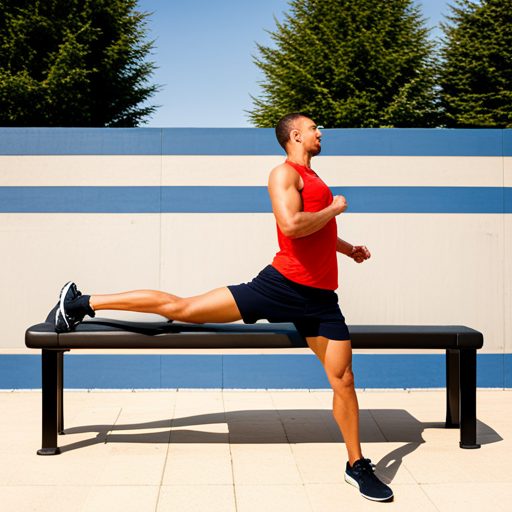Essential Warm-Up Exercises Before a Run
Are you tired of feeling stiff and sluggish during your runs? Well, look no further! In this article, we will guide you through a range of essential warm-up exercises that are guaranteed to transform your running experience.
Get ready to discover the power of a proper warm-up routine as we dive into dynamic stretches to loosen up those muscles, activation exercises to prime your body, balance and coordination drills for improved performance, and mobility exercises to enhance your range of motion.
Say goodbye to discomfort and hello to peak performance!
The Importance of a Proper Warm-Up Routine
You should always prioritize a proper warm-up routine before running to prevent injuries and enhance your performance. A warm-up routine is crucial because it prepares your body for the physical demands of running and reduces the risk of injury. By increasing blood flow to your muscles, a warm-up routine helps improve muscle flexibility and range of motion, making them less prone to strains or tears during exercise.
One of the key benefits of a warm-up routine is injury prevention. When you engage in dynamic stretches, such as leg swings or arm circles, you activate the muscles that will be utilized during your run. This increases blood flow and oxygen delivery to those muscles, which helps reduce muscle stiffness and minimizes the risk of muscle imbalances that can lead to injury.
In addition to injury prevention, a proper warm-up routine also enhances your overall performance. By gradually increasing your heart rate and breathing rate through light aerobic exercises like jogging or jumping jacks, you prepare your cardiovascular system for the upcoming exertion. This ensures that oxygen-rich blood is readily available to fuel your working muscles during your run.
To optimize recovery after a run, it’s equally important to properly cool down. After completing your run, take five to ten minutes for gentle walking or slow jogging. This allows your heart rate and breathing rate to gradually return to normal levels while aiding in flushing out metabolic waste products from exercising muscles.
Dynamic Stretches to Loosen Up Muscles
Dynamic stretches will help loosen up your muscles before a run. Engaging in pre-run rituals is crucial for injury prevention and optimizing performance. By incorporating dynamic stretches into your warm-up routine, you can prepare your body for the demands of running and enhance your overall running experience.
Dynamic stretching involves active movements that mimic the actions you’ll perform during your run. These stretches not only increase blood flow to the muscles but also improve flexibility, range of motion, and muscle activation. They are an effective way to warm up specific muscle groups while reducing the risk of injury.
Here is a table that highlights four dynamic stretches you can incorporate into your pre-run warm-up:
| Stretch | Muscle Group | Benefits |
|---|---|---|
| Leg Swings | Hamstrings | Increases flexibility |
| Walking Lunges | Quadriceps | Improves hip mobility and balance |
| Arm Circles | Shoulders | Enhances upper body mobility |
| High Knees | Hip Flexors | Activates core muscles and improves coordination |
Remember to perform these stretches dynamically, meaning they should be done in a controlled yet fluid manner without holding any position for too long. Aim for 10-12 repetitions on each leg or arm depending on the stretch.
Incorporating dynamic stretches into your pre-run warm-up routine is essential for preventing injuries and optimizing performance. By taking a few minutes to properly prepare your muscles, you’ll set yourself up for a successful run with reduced risk of strains, pulls, or other muscular issues. So make sure to include these exercises in your pre-run rituals and enjoy a safer and more productive running experience!
Activation Exercises to Prime Your Body for Running
To properly prime your body for running, incorporating activation exercises is crucial. These exercises help activate and engage the specific muscles that are essential for a successful run. By performing activation exercises before your run, you can improve your performance and reduce the risk of injuries.
Here are three key activation exercises that you should include in your pre-run preparation:
1. Glute bridges: Lie on your back with knees bent and feet flat on the ground. Lift your hips up towards the ceiling while squeezing your glutes. Hold for a few seconds and then lower down. This exercise activates your glutes, which play a vital role in stabilizing the pelvis during running.
2. High knees: Stand tall with arms by your sides. Lift one knee towards chest height, while keeping a quick pace, alternate knees as if marching in place but exaggerating the lift of each knee to engage hip flexors, quads, and core muscles.
3. Ankle circles: Stand with feet shoulder-width apart and raise one foot off the ground slightly. Rotate that ankle clockwise 10 times, then counter-clockwise 10 times before switching to the other ankle. This exercise helps warm up ankle joints and increase mobility.
Incorporating these activation exercises into your pre-run routine will not only help prevent injuries but also improve muscle recruitment and overall running efficiency. Remember to listen to your body and modify or adjust any exercise if necessary to avoid strain or discomfort.
Balance and Coordination Drills for Improved Performance
Incorporating balance and coordination drills into your pre-run routine can greatly enhance your performance. These exercises not only improve your body’s ability to maintain stability and control, but they also help develop better proprioception and agility for increased speed and efficiency during your runs.
Proprioception exercises focus on improving body awareness, which is crucial for maintaining proper form and preventing injuries. By challenging your balance and spatial awareness, you can train your body to make subtle adjustments in posture and alignment while running. This helps reduce the risk of overuse injuries caused by imbalances or compensations.
Agility drills, on the other hand, target quick movements, change of direction, and rapid acceleration. These drills improve your ability to react swiftly to changes in terrain or obstacles during a run. By enhancing agility, you’ll be able to navigate uneven surfaces with ease, maintain a faster pace when needed, and avoid tripping or falling.
Here are some examples of balance and coordination exercises that you can incorporate into your warm-up routine:
| Proprioception Exercises | Agility Drills |
| Single-leg squats | Ladder drills |
| Bosu ball exercises | Cone slalom |
| Standing on one leg | Shuttle runs |
Mobility Exercises to Enhance Range of Motion

Why not try adding mobility exercises to your routine to improve your range of motion? Joint mobility is an essential component of overall fitness and can greatly enhance your athletic performance.
By incorporating flexibility training into your workout regimen, you can increase the suppleness of your muscles and joints, allowing for greater freedom of movement and reducing the risk of injury.
Here are three key benefits of integrating mobility exercises into your fitness routine:
1. Improved joint health: Mobility exercises help to lubricate the joints, promoting better synovial fluid production and increasing their overall resilience. This can result in reduced joint pain and stiffness, allowing you to move more freely during physical activities.
2. Increased range of motion: Regular mobility training can lead to improved flexibility, enabling you to achieve a greater range of motion in various movements and exercises. This increased range can enhance performance in sports such as running, yoga, or weightlifting.
3. Injury prevention: Engaging in targeted mobility exercises helps to strengthen the muscles surrounding the joints, providing added stability and support. By improving joint stability through mobility training, you reduce the likelihood of experiencing common injuries such as sprains or strains.
Incorporating mobility exercises into your routine is simple and highly beneficial for overall joint health and physical performance. Whether it’s through dynamic stretches or specific joint mobilization drills, dedicating time to improving your range of motion will undoubtedly enhance both your workouts and daily life activities.
Conclusion
Congratulations! You’ve reached the finish line of this article, and now you’re equipped with essential knowledge on warm-up exercises before a run.
By incorporating dynamic stretches, activation exercises, balance drills, and mobility exercises into your routine, you’ll not only enhance your performance but also reduce the risk of injury.
Just like a well-tuned engine before a race, warming up your body is crucial for optimal running experience.
So lace up those shoes and let your warm-up be the secret ingredient to an enjoyable and successful run!


